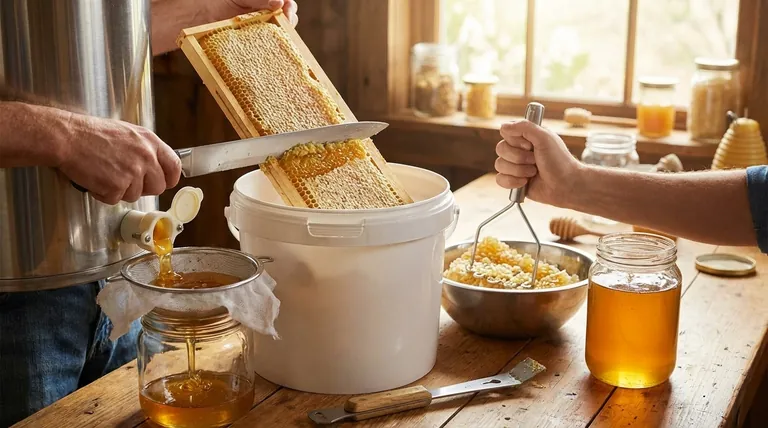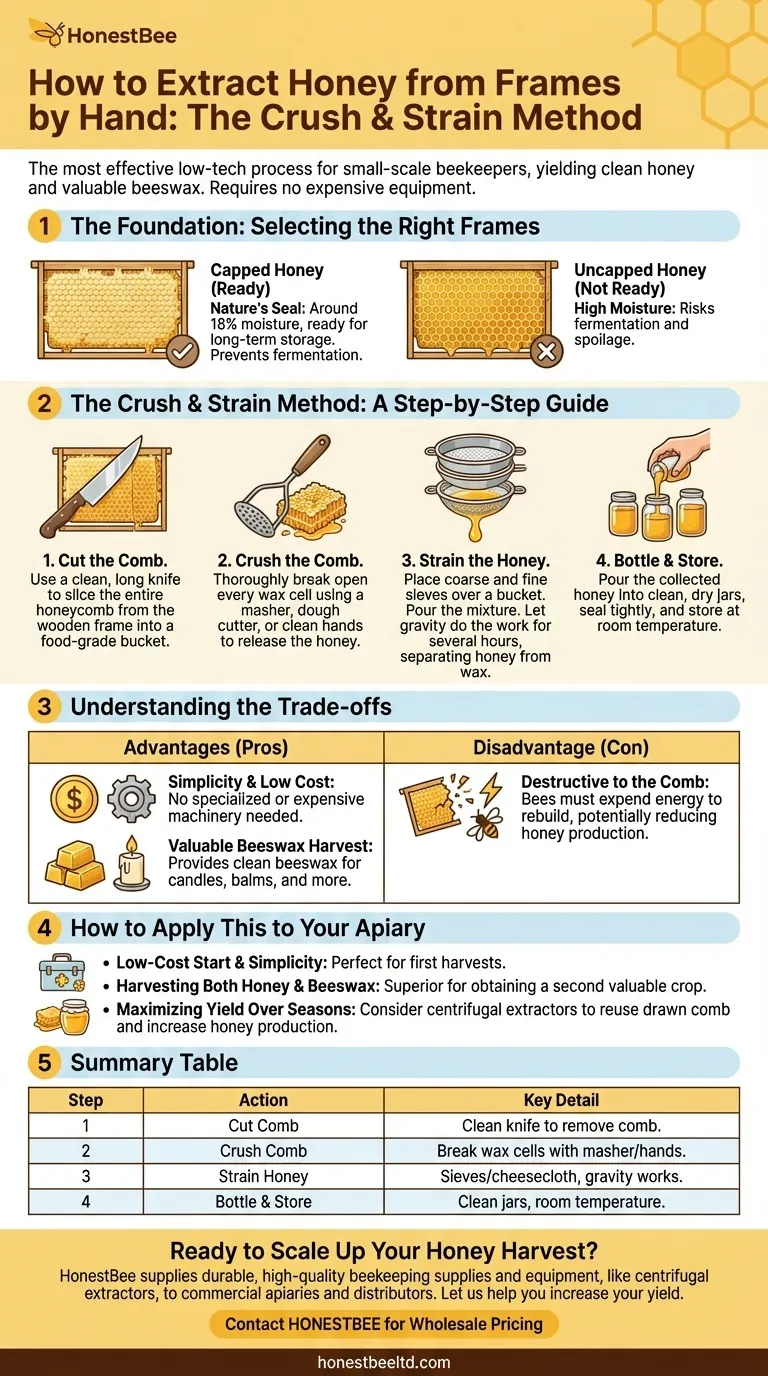The most effective way to extract honey from frames by hand is using the "crush and strain" method. This simple, low-tech process involves cutting the honeycomb from the frame, crushing it to release the honey from the wax cells, and then straining the mixture to separate the pure honey from the wax debris.
Crush and strain is a time-honored technique perfectly suited for small-scale or beginner beekeepers. It requires no expensive equipment and provides the added benefit of yielding a clean harvest of both honey and valuable beeswax.

The Foundation: Selecting the Right Frames
Before you begin any extraction, a proper inspection is critical. Harvesting honey at the right time ensures a quality product that will not spoil.
Why Capped Honey is Crucial
Honey that is ready for harvest is "capped" with a fresh, yellow-white wax coating. This cap signifies that the bees have reduced the honey's moisture content to the correct level (around 18%).
Harvesting uncapped honey with high moisture content can lead to fermentation, spoiling your entire batch. Capped honey is nature's seal of approval, indicating it's ready for long-term storage.
What to Look For
Inspect your frames and choose those that are at least 80% covered with this waxy coating. A fully capped frame is a clear sign that the honey is ripe and ready for extraction.
The Crush and Strain Method: A Step-by-Step Guide
This process is straightforward, but preparing your workspace will minimize mess and maximize your yield, keeping both you and your bees happy.
Step 1: Cut the Comb from the Frame
Using a clean, long knife, carefully slice the entire honeycomb away from the wooden frame. Let the comb fall into a food-grade bucket or a large, clean bowl.
Step 2: Crush the Comb
The goal is to break open every single wax cell. You can use a potato masher, a dough cutter, or even just your clean hands to thoroughly crush the comb and wax mixture.
Step 3: Strain the Honey
Set up a straining system. A simple method is to place a coarse sieve over a bucket and a finer sieve or cheesecloth over that. Pour the crushed comb and honey mixture into the top strainer.
Gravity will do most of the work, but this can take several hours or even overnight. Be patient and allow the honey to slowly drip through, leaving the wax behind.
Step 4: Bottle and Store
Once all the honey has been collected in your bucket, it is ready to be poured into clean, dry jars. Seal them tightly and store them at room temperature.
Understanding the Trade-offs
The crush and strain method is excellent, but it's important to understand its pros and cons compared to centrifugal extraction.
Advantage: Simplicity and Low Cost
This method requires no specialized or expensive machinery. A few buckets, a knife, and some strainers are all you need to get started.
Advantage: A Valuable Beeswax Harvest
Unlike centrifugal extraction which leaves the comb intact, this method provides you with a large amount of clean beeswax. This precious byproduct can be rendered and used for candles, balms, or polishes.
Disadvantage: It is Destructive to the Comb
The primary drawback is that you are destroying the comb. Your bees will have to expend significant energy and resources to rebuild that comb from scratch, which could have been used to produce more honey.
How to Apply This to Your Apiary
Choosing your extraction method depends entirely on your goals as a beekeeper.
- If your primary focus is a low-cost start and simplicity: The crush and strain method is the perfect choice for your first few harvests.
- If your primary focus is harvesting both honey and beeswax: This method is superior, as it provides a significant quantity of wax as a valuable second crop.
- If your primary focus is maximizing honey yield over many seasons: You may eventually consider a centrifugal extractor, as reusing drawn comb allows bees to focus solely on honey production.
Ultimately, the crush and strain method is a highly effective and rewarding way to process your first honey harvest.
Summary Table:
| Step | Action | Key Detail |
|---|---|---|
| 1 | Cut Comb | Use a clean knife to remove comb from frame. |
| 2 | Crush Comb | Break wax cells with a masher or hands. |
| 3 | Strain Honey | Use sieves/cheesecloth; let gravity work. |
| 4 | Bottle & Store | Pour into clean, dry jars for storage. |
Ready to scale up your honey harvest?
As your apiary grows, efficient equipment becomes essential. HONESTBEE supplies durable, high-quality beekeeping supplies and equipment—like centrifugal extractors and uncapping tools—to commercial apiaries and beekeeping equipment distributors through our wholesale-focused operations.
Let us help you increase your yield and streamline your process. Contact HONESTBEE today for wholesale pricing and expert advice tailored to your operation.
Visual Guide

Related Products
- 2 Frame Stainless Steel Manual Honey Spinner Extractor for Beekeeping
- 6 Frame Manual Stainless Steel Honey Extractor Beekeeping Equipment
- HONESTBEE 3-Frame Manual Acrylic Honey Extractor
- Electric 8 Frame Honey Spinner Extractor Equipment for Beekeeping
- Stainless Steel 3 Frame Manual Honey Extractor Spinner for Bee Honey Extraction
People Also Ask
- How do beekeepers harvest honey from the honey super? A Step-by-Step Guide to Efficient Extraction
- Can a manual extractor be upgraded to an electric one? Save Labor & Boost Efficiency
- What mistakes should be avoided during honey extraction with a centrifuge? Preserve Your Comb and Honey Quality
- What are the consequences of leaving honey in an extractor? Protect Your Honey Quality and Equipment
- What are the advantages of tangential honey extractors? Gentle, Affordable Honey Extraction for Your Apiary



















